TOYOTA DYNA 100/150 2012 Owners Manual (in English)
Manufacturer: TOYOTA, Model Year: 2012, Model line: DYNA 100/150, Model: TOYOTA DYNA 100/150 2012Pages: 240, PDF Size: 15.05 MB
Page 131 of 240

INFORMATION BEFORE DRIVING YOUR TOYOTA125
When the anti−lock brake system is ac-
tivated, the following conditions may
occur. They do not indicate a malfunc-
tion of the system:
DYou may hear the anti−lock brake sys-
tem operating and feel the brake pedal
pulsating and the vibrations of the ve-
hicle body and steering wheel. You
may also hear the motor sound from
the area around the front axle even
after the vehicle is stopped.
DAt the end of the anti−lock brake sys-
tem activation, the brake pedal may
movealittleforward.
CAUTION
Do not overestimate the anti−lock
brake system: Although the anti−lock
brake system assists in providing ve-
hicle control, it is still important to
drive with all due care and maintain
a moderate speed and safe distance
from the vehicle in front of you, be-
cause there are limits to the vehicle
stability and effectiveness of steering
wheel operation even with the anti−
lock brake system on.
If tire grip performance exceeds its
capability, or if hydroplaning occurs
during high speed driving in the rain,
the anti−lock brake system does not
provide vehicle control.
Anti−lock brake system is not de-
signed to shorten the stopping dis-
tance: Always drive at moderate
speed and maintain a safe distance
from the vehicle in front of you.
Compared with vehicles without an
anti−lock brake system, your vehicle
may require a longer stopping dis-
tance in the following cases:
DDriving on rough, gravel or snow−
covered roads.
DDriving with tire chains installed.
DDriving over the steps such as the
joints on the road.
DDriving on roads where the road
surface is pitted or has other differ-
ences in surface height.
Install all tires of specified size at
appropriate pressure: The anti−lock
brake system detects vehicle speeds
using the speed sensors for respec-
tive wheels’ turning speeds. The use
of tires other than specified may fail
to detect the accurate turning speed
resulting in a longer stopping dis-
tance.
Dyna100/150_EE
Page 132 of 240
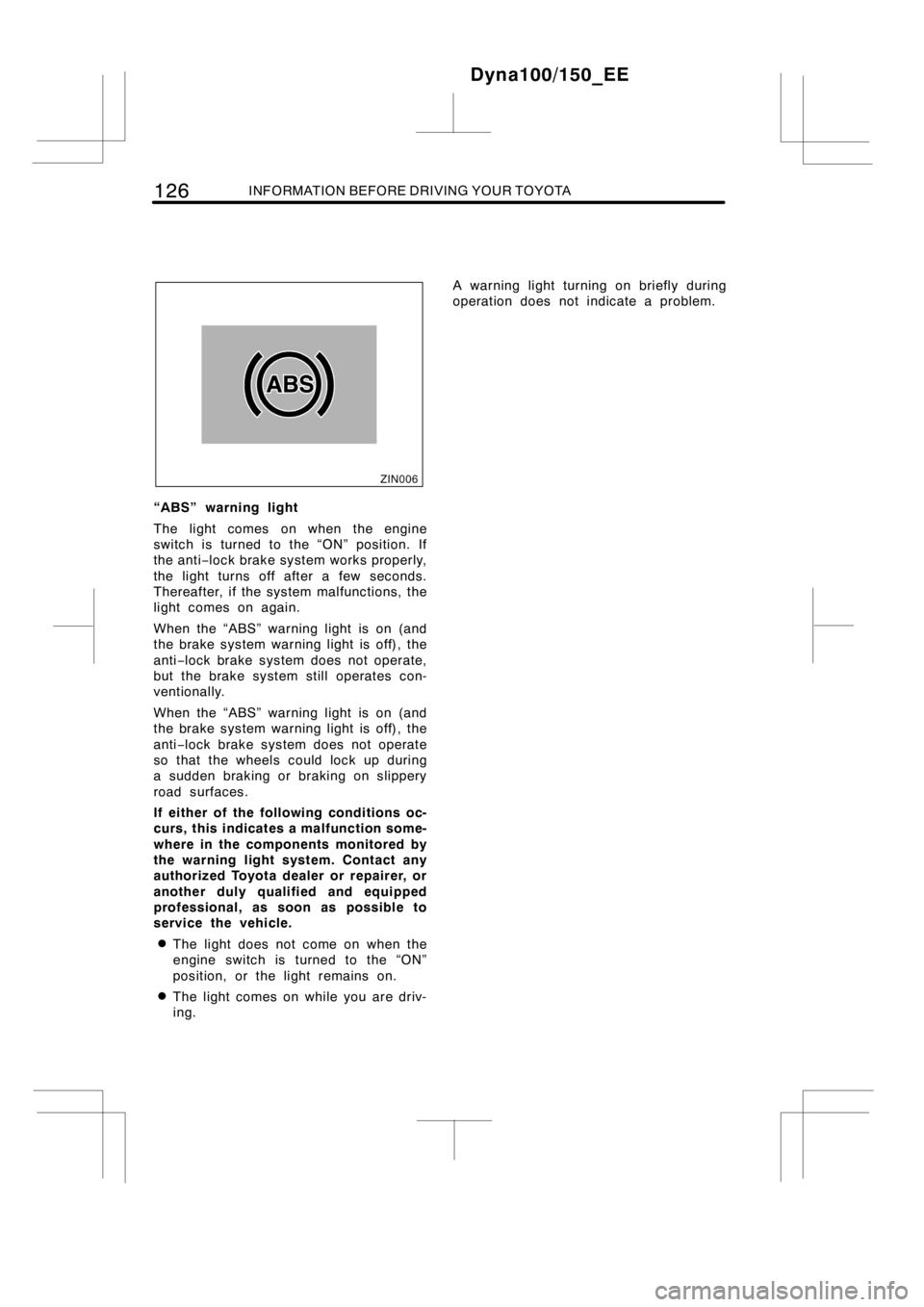
126INFORMATION BEFORE DRIVING YOUR TOYOTA
“ABS” warning light
The light comes on when the engine
switch is turned to the “ON” position. If
the anti−lock brake system works properly,
the light turns off after a few seconds.
Thereafter, if the system malfunctions, the
light comes on again.
When the “ABS” warning light is on (and
the brake system warning light is off), the
anti−lock brake systemdoes not operate,
but the brake system stilloperates con-
ventionally.
When the “ABS” warning light is on (and
the brake system warning light is off), the
anti−lock brake systemdoes not operate
so that the wheels could lock up during
a sudden braking or braking on slippery
road surfaces.
If either of the following conditions oc-
curs, this indicates a malfunction some-
where in the components monitored by
the warning light system. Contact any
authorized Toyota dealer or repairer, or
another duly qualified and equipped
professional, as soon as possible to
service the vehicle.
DThe light does not come on when the
engine switch is turned to the “ON”
position, or the light remains on.
DThe light comes on while you are driv-
ing.A warning light turning on briefly during
operation does not indicate a problem.
Dyna100/150_EE
Page 133 of 240
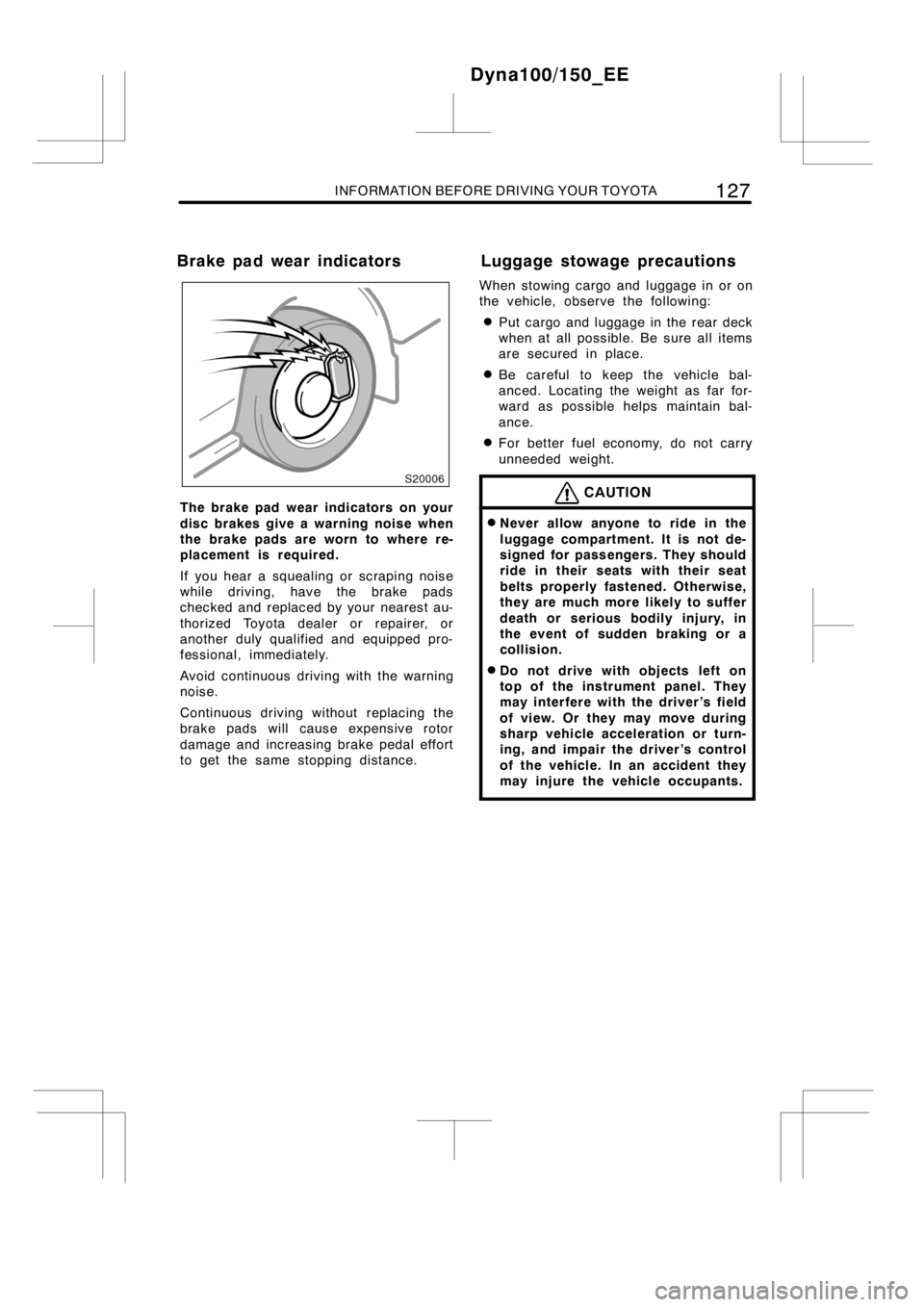
INFORMATION BEFORE DRIVING YOUR TOYOTA127
The brake pad wear indicators on your
disc brakes give a warning noise when
the brake pads are worn to where re-
placement is required.
If you hear a squealing or scraping noise
while driving, have the brake pads
checked and replaced by your nearest au-
thorized Toyota dealer or repairer, or
another duly qualified and equipped pro-
fessional, immediately.
Avoid continuous driving with the warning
noise.
Continuous driving without replacing the
brake pads will cause expensive rotor
damage and increasing brake pedal effort
to get the same stopping distance.When stowing cargo and luggage in or on
the vehicle, observe the following:
DPut cargo and luggage in the rear deck
when at all possible. Be sure all items
are secured in place.
DBe careful to keep the vehicle bal-
anced. Locating the weight as far for-
ward as possible helps maintain bal-
ance.
DFor better fuel economy, do not carry
unneeded weight.
CAUTION
DNever allow anyone to ride in the
luggage compartment. It is not de-
signed for passengers. They should
ride in their seats with their seat
belts properly fastened. Otherwise,
they are much more likely to suffer
death or serious bodily injury, in
the event of sudden braking or a
collision.
DDo not drive with objects left on
top of the instrument panel. They
may interfere with the driver’s field
of view. Or they may move during
sharp vehicle acceleration or turn-
ing, and impair the driver ’s control
of the vehicle. In an accident they
may injure the vehicle occupants.
Dyna100/150_EE
Brake pad wear indicators Luggage stowage precautions
Page 134 of 240
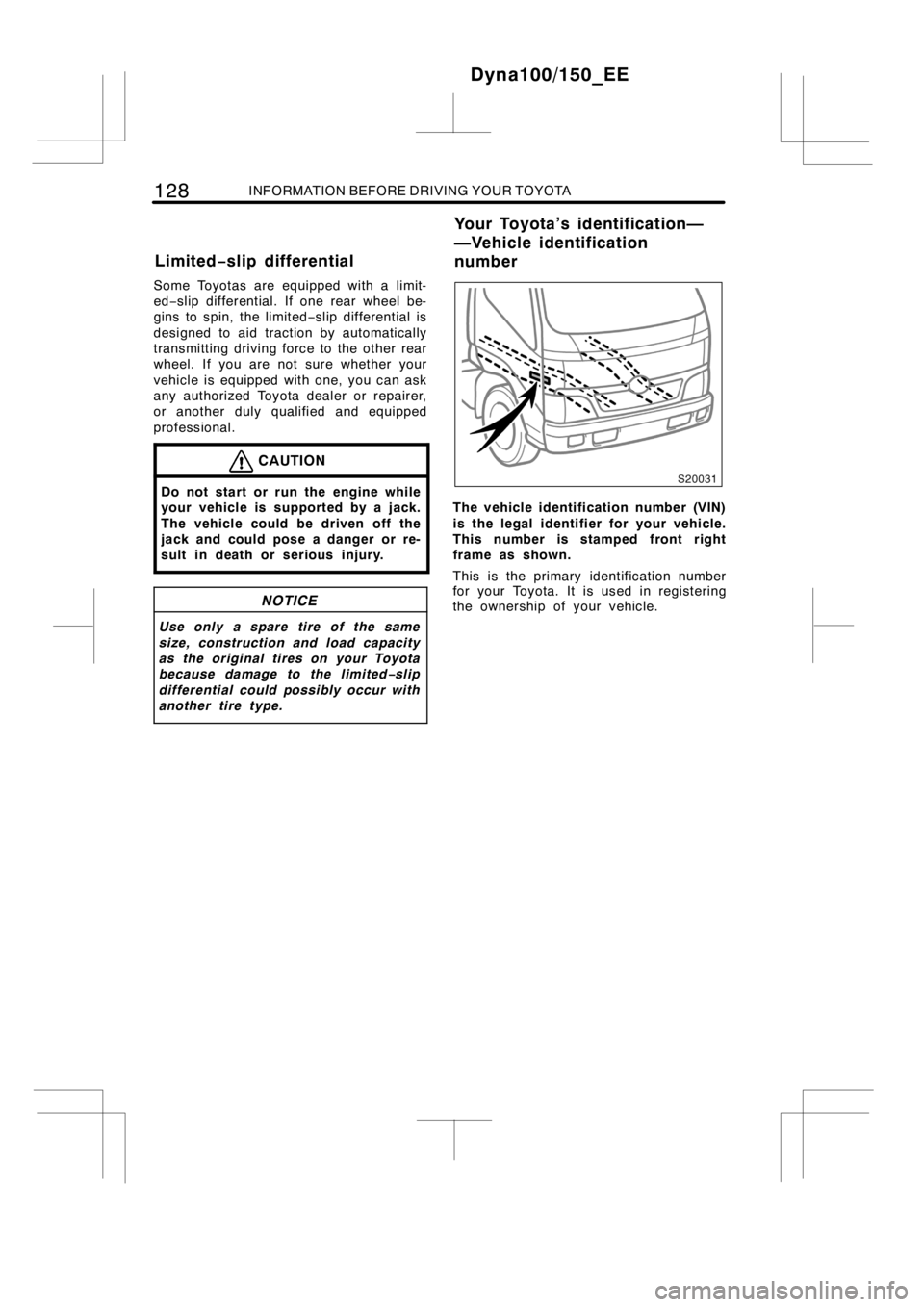
128INFORMATION BEFORE DRIVING YOUR TOYOTA
Some Toyotas are equipped with a limit-
ed−slip differential. If one rear wheel be-
gins to spin, the limited−slip differential is
designed to aid traction by automatically
transmitting driving force to the other rear
wheel. If you are not sure whether your
vehicle is equipped with one, you can ask
any authorized Toyota dealer or repairer,
or another duly qualified and equipped
professional.
CAUTION
Do not start or run the engine while
your vehicle is supported by a jack.
The vehicle could be driven off the
jack and could pose a danger or re-
sult in death or serious injury.
NOTICE
Use only a spare tire of the same
size, construction and load capacity
as the original tires on your Toyota
because damage to the limited−slip
differential could possibly occur with
another tire type.
The vehicle identification number (VIN)
is the legal identifier for your vehicle.
This number is stamped front right
frameasshown.
This is the primary identification number
for your Toyota. It is used in registering
the ownership of your vehicle.
Dyna100/150_EE
Limited−slip differentialYour Toyota’s identification—
—Vehicle identification
number
Page 135 of 240
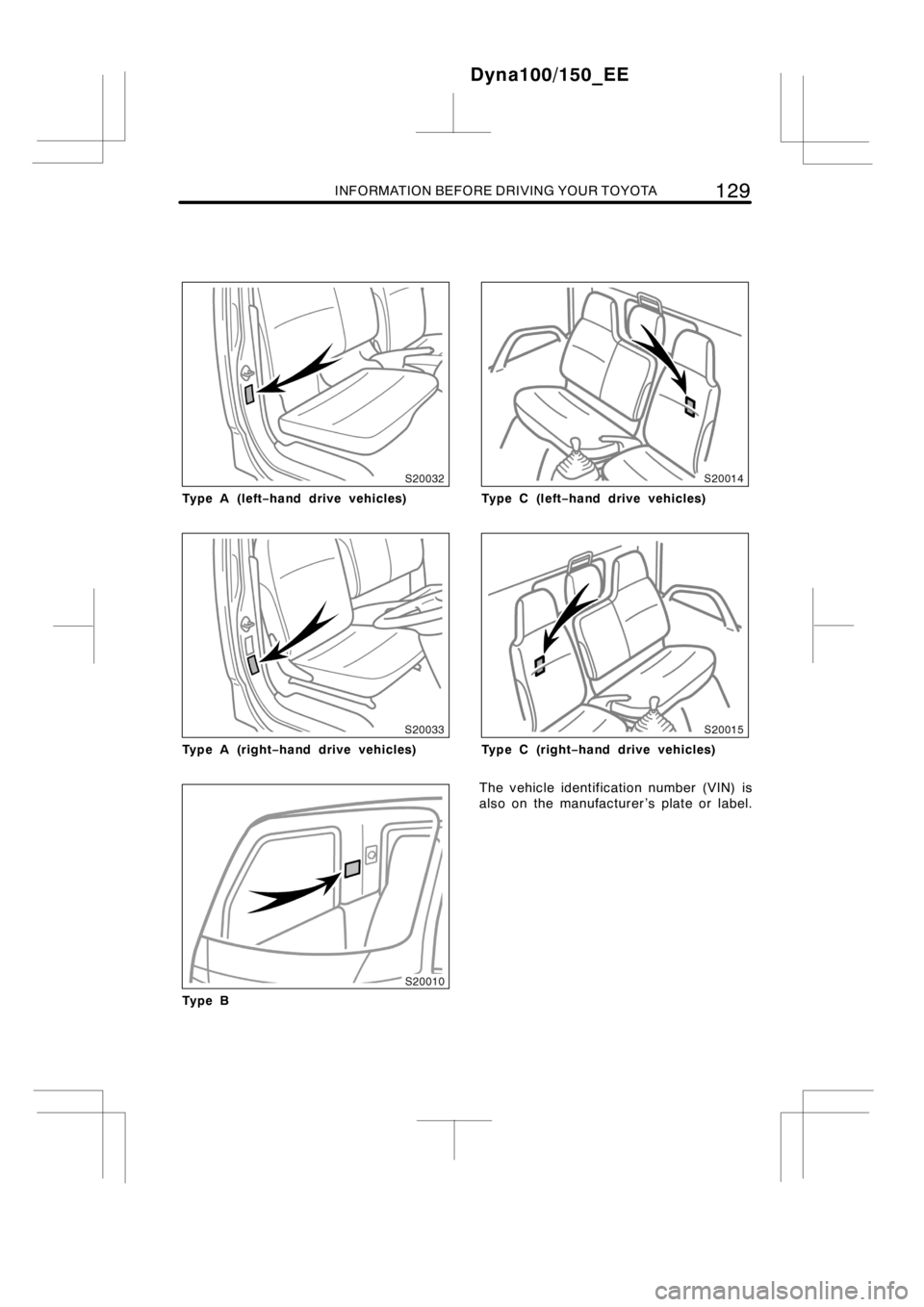
INFORMATION BEFORE DRIVING YOUR TOYOTA129
Ty p e A ( l e f t−hand drive vehicles)
Type A (right−hand drive vehicles)
Ty p e B
Ty p e C ( l e f t−hand drive vehicles)
Type C (right−hand drive vehicles)
The vehicle identification number (VIN) is
also on the manufacturer ’s plate or label.
Dyna100/150_EE
Page 136 of 240
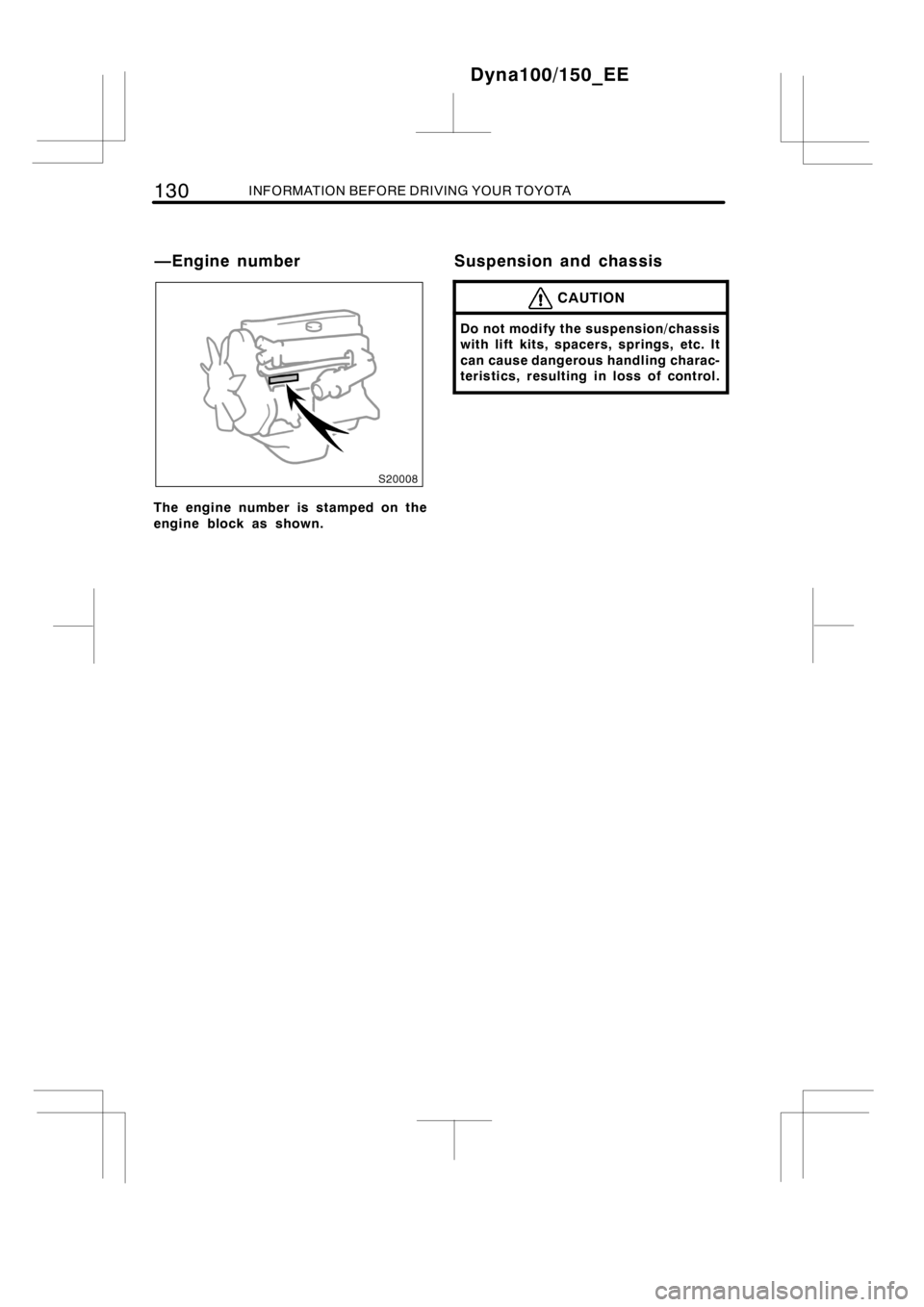
130INFORMATION BEFORE DRIVING YOUR TOYOTA
The engine number is stamped on the
engine block as shown.
CAUTION
Do not modify the suspension/chassis
with lift kits, spacers, springs, etc. It
can cause dangerous handling charac-
teristics, resulting in loss of control.
Dyna100/150_EE
—Engine number Suspension and chassis
Page 137 of 240

STARTING AND DRIVING131
Section 3
STARTING AND DRIVING
DBefore starting the engine 132..........................
DHow to start the engine 132.............................
DPrecautions for turning off an engine
with turbocharger 134..................................
DPre−trip safety check 134..............................
DTips for driving in various conditions 135.................
DDriving in the rain 136..................................
DWinter driving tips 137.................................
DTrailer towing 138......................................
DHow to save fuel and make your vehicle last longer 146...
Dyna100/150_EE
Page 138 of 240

132STARTING AND DRIVING
1. Check the area around the vehicle be-
fore entering it.
2. Adjust seat position, seatback angle,
steering wheel angle and length.
3. Adjust the inside and outside rear view
mirrors.
4. Close all doors.
5. Fasten seat belts.1. Apply the parking brake firmly.
2. Turn off unnecessary lights and acces-
sories.
3. Press the clutch pedal to the floor and
shift the transmission into neutral. Hold
the clutch pedal to the floor until the
engine is started.
Dyna100/150_EE
Before starting the engineHow to start the engine—
(a) Before cranking
Page 139 of 240

STARTING AND DRIVING133
Before starting the engine, be sure to fol-
low the instructions in “(a) Before crank-
ing”.
Normal starting procedure
1. Turn the key to “ON” and verify that
the engine preheating indicator light
has come on. Keep the key in that
position until the light goes off.
2. With your foot off the accelerator ped-
al, crank the engine by turning the key
to “START”. Release it when the en-
gine starts.
Engine should be warmed up by driving,
not in idle. For warming up, drive with
smoothly turning engine until engine cool-
ant temperature is within normal range.
If the engine stalls...
Simply restart it, using the correct proce-
dure given above, depending on the en-
gine temperature.
If the engine will not start...
See “If your vehicle will not start” on page
150 in Section 4.
NOTICE
zDo not crank for more than 30 se-
conds at a time. This may overheat
the starter and wiring systems.
zDo not race a cold engine.
zIf the engine becomes difficult to
start or stalls frequently, have the
engine checked immediately.
Dyna100/150_EE
(b) Starting the engine
Page 140 of 240

134STARTING AND DRIVING
After high−speed or extended driving that
requires a heavy engine load, the engine
should be allowed to idle, as shown in the
chart before turning it off.
Driving condition and required idling
time
Normal city driving
Idling time—Not necessary
High−speed driving
About 80 km/h (50 mph)
Idling time—About 20 seconds
About 100 km/h (62 mph)
Idling time—About 1 minute
Steep mountain slopes or continued
driving above 100 km/h (62 mph)
Idling time—About 2 minute
NOTICE
Do not turn the engine off immediate-
ly after a heavy load has been placed
on the engine in order to prevent en-
gine damage.
It is a good idea to do a safety check
before starting out on a trip. A few min-
utes of checking can help ensure safe and
pleasant driving. Just a basic familiarity
with your vehicle is required and a careful
eye! Or, if you would like, any authorized
Toyota dealer or repairer, or another duly
qualified and equipped professional, will
be pleased to make this check for you at
a nominal cost.
CAUTION
If you make this check in an enclosed
garage, make sure there is adequate
ventilation. Engine exhaust is poison-
ous.
BEFORE STARTING THE ENGINE
Outside the vehicle
Tires (spare included).Check the pres-
sure with a gauge and look carefully for
cuts, damage, or excessive wear.
Wheel nuts.Make sure no nuts are mis-
sing or loose.
Fluid leaks.After the vehicle has been
parked for a while, check underneath for
leaking fuel, oil, water, or fluid.
Lights.Make sure the headlights, stop
lights, tail lights, turn signals and other
lights are all working. Check the headlight
aim.
Battery and cables.All the battery cells
should be filled to theproper level with
distilled water. Look for corroded or loose
terminals and a cracked case. Check the
cables for good condition and connections.
Inside the vehicle
Jack and wheel nut wrench.Make sure
you have your jack and wheel nut wrench.
Seat belts.Check that the buckles lock
securely. Make sure the belts are not
worn or frayed.
Dyna100/150_EE
Precautions for turning off
an engine with turbochargerPre−trip safety check